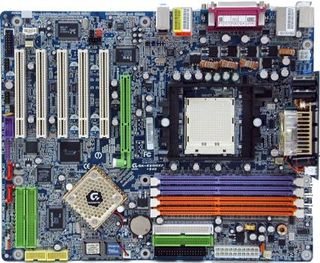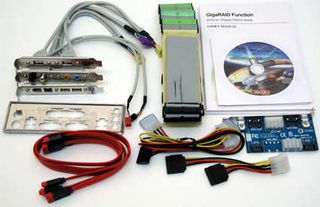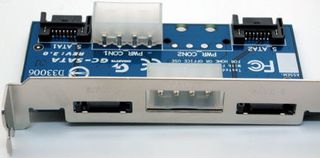Avant-Garde: Four boards for AMD's Athlon 64 FX
Gigabyte GA-K8NNXP-940

Click to enlarge.
Board Revision: 1.0
BIOS Version: M01 (September 12, 2003)
The K8NNXP-940 is easily made into a Gigabyte board for connoisseurs. The turquoise board is typical, as are the colored DIMM sockets and the usually high number of additional components. In the case of this board there is an UltraATA/133 RAID controller (GigaRAID), Gigabit Ethernet controller, a secondary 100-Mbit controller and a sound system from Realtek (see the table of features). Last but not least, the manufacturer also thought to include a Serial ATA chip, because more and more frequently, this new and simpler interface is the one used.
The color choices of the DIMM sockets are somewhat misleading - usually the sockets belonging to one channel are kept in one color. Not so with the K8NNXP: the two same-color sockets, which belong next to each other, are for mounting channels A and B.
Gigabyte offers the widest range of setting and overclocking options. For example, the memory parameters can be programmed in a scope that will give even experienced users food for thought. Very good: Gigabyte even allows modification of the multiplier, even if this is not supposed to be modifiable. The only oldernative for the overclocker is to raise the system speed. In order to support this, the K8NNXP also allows the chipset voltage to be changed.
Gigabyte theoretically uses the better voltage conversion, because it should be possible to synchronize them (thus raising efficiency) using the three-phase switching controllers on the board and additional three-phase switches on the DPS daughterboard.
Stay on the Cutting Edge
Join the experts who read Tom's Hardware for the inside track on enthusiast PC tech news — and have for over 25 years. We'll send breaking news and in-depth reviews of CPUs, GPUs, AI, maker hardware and more straight to your inbox.
Even the package contents leave nothing to be desired, because digital audio connections, more FireWire and USB 2.0 ports are available in the form of slot expansion modules. What's more, there is an adapter that allows external operation of Serial ATA drives. Unusual, but very practical, if it is ever needed.
Only the power of the Gigabyte board was slightly below the otherwise excellent overall impression. The nForce3-150 chipset exhibits the typical weakness due to the lower speed of the Hypertransport- channel, a problem that Gigabyte can do nothing about. The performance of the Asus SK8N, however, is hardly better, but that can be fixed in the course of a BIOS update.

Exemplary: several slot adapters for additional interfaces and other audio connectors (S/PDIF), SATA cables and the appropriate power adapters, along with a complete set of ribbon cables.

This board offers everything to make up to two SATA ports accessible from the outside. Except, of course, sufficient extension power cables and a SATA cable.
Most Popular

